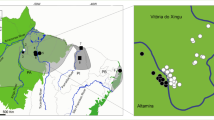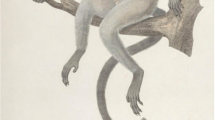Abstract
The taxonomic relationships among the four genera of the Atelidae family, Alouatta (Howler), Ateles (Spider), Lagothrix (Woolly) and Brachyteles (Muriqui), have been the subject of great debate. In general, almost all authors agree with the assignment of Howler monkeys as the basal genus, either in its own tribe Alouattini or in the subfamily Alouattinae, but they disagree on the associations among the other members of the family. Muriquis have been grouped with Spider monkeys based on the fact that they share various behavioral and morphological characteristics. Cladistic analyses using morphological, biochemical, karyotype and behavioral characteristics depicted a phylogenetic tree that places Howler as the basal genus and the remaining genera in an unresolved politomy. More recent studies using molecular data have suggested that Muriqui and Woolly monkeys are sister groups. However, a recent study based on nuclear and mtDNA argued that politomy is what best represents the relationships among Spider, Woolly and Muriqui. To contribute to this debate we have added new data from two nuclear genes, Transferrin and von Willebrand Factor, and using an alignment of 17,997 bp we demonstrate that a total analysis strongly supports the Muriqui-Woolly clade. A gene-to-gene approach showed that four of the eight nuclear genes provide support for the Muriqui-Woolly clade, two strongly and two moderately, while none of the eight genes provide support for any alternative arrangement. The mitochondrial genes were not able to resolve the politomy. A possible reason for the difficulty in resolving atelid relationships may be the short period of time separating each cladogenetic event in the evolutionary process that shaped this family.


Similar content being viewed by others
References
Ascunce MS, Hasson E, Mudry MD (2002) Description of the cytochrome c oxidase subunit II gene in some genera of New World Monkeys (Primates, Platyrrhini). Genetica 114:253–517
Barroso CML, Schneider H, Schneider MPC, Sampaio I, Harada ML, Czelusniak J, Goodman M (1997) Update on the phylogenetic systematics of New World monkeys: further DNA evidence for placing the pygmy marmoset (Cebuella) within the genus Callithrix. Int J Primatol 18:651–674
Bremer K (1994) Branch support and tree stability. Cladistics 10:295–304
Canavez FC, Moreira MAM, Simon F, Parham P, Seuánez HN (1999) Phylogenetic relationships of the Callitrichinae (Platyrrhini, Primates) based on ß2-microglobulin DNA sequences. Am J Primatol 48:225–236
Chaves R, Sampaio I, Schneider MPC, Schneider H, Page SL, Goodman M (1999) The place of Callimico goeldii in the Callitrichine phylogenetic tree: evidence from von Willebrand factor gene intron II sequences. Mol Phylogenet Evol 13:392–404
Chen W-J, Bonillo C, Locointre G (2003) Repeatability of clades as a criterion of reliability: a case study for molecular phylogeny of acanthomorpha (teleostei) with larger number of taxa. Mol Phylogenet Evol 26:262–288
Chiu C, Schneider H, Schneider MPC, Sampaio I, Meireles C, Slightom JL, Gumucio DL, Goodman M (1996) Reduction of two functional γ-globin genes to one: an evolutionary trend in New World monkeys (infraorder Platyrrhini). Proc Natl Acad Sci USA 93:6510–6515
Collins AC (2004) Atelinae phylogenetic relatioships: the trichotomy revived? Am J Phys Anthropol 124:285–296
Collins AC, Dubach J (2000) Phylogenetic relationships among populations of spider monkeys (Ateles): based on analysis of mitochondrial DNA variation. Int J Primatol 21:381–420
Cortes-Ortiz L, Bermingham E, Rico C, Rogriguez-Luna E Sampaio I, Ruiz-Garcia M (2003) Systematics and biogeography of the Neotropical monkey genus Alouatta. Mol Phylogenet Evol 26:64–81
Farris JS, Kallersjo M, Kluge AG, Bult C (1995) Testing significance of incongruence. Cladistics 10:315–319
Fitch DHA, Mainone C, Goodman M, Slightom JL (1990) Molecular history of gene conversions in the primate fetal y-globin genes. J Biol Chem 265:78l–793
Ford SM (1986) Systematics of the New World monkeys In: Swindler DR, Erwin J (eds) Comparative primate biology. Systematics, evolution, and anatomy, vol 1. A.R. Liss, New York, pp 73–135
Ford SM, Davis LC (1992) Systematics and body size implications for feeding adaptations in New World monkeys. Am J Phys Anthropol 88:415–468
Goodman M, Porter CA, Czelusniak J, Page SL, Schneider H, Shoshani J, Gunnell G, Groves CP (1998) Toward a phylogenetic classification of primates based on DNA evidence complemented by fossil evidence. Mol Phylogenet Evol 9:585–598
Guindon S, Gascuel OA (2003) Simple, fast, and accurate algorithm to estimate large phylogenies by maximum likelihood. Syst. Biol 52:696–704
Hall TA (1999) BioEdit: a user-friendly biological sequence alignment editor and analysis program for Windows 95/98/NT. Nucleic Acids Symp Ser 41:95–98
Harada ML, Schneider H, Schneider MPC, Sampaio I, Czelusniak J, Goodman M (1995) DNA evidence of the phylogenetic systematics of New World monkeys: support for the sistergrouping of Cebus and Saimiri from two unlinked nuclear genes. Mol Phylogenet Evol 4:331–349
Hershkovitz P (1977) Living new World monkeys (Platyrrhini) with an introduction to primates, vol I. University of Chicago Press, Chicago
Hill WCO (1962) Primates, comparative anatomy and taxonomy, vol V, cebidae part B. University Press, Edinburgh
Horovitz I, Meyer A (1995) Systematics of New World monkeys (Platyrrhini, Primates) based on 16S mitochondrial DNA sequences: a comparative analysis of different weighting methods in cladistic analysis. Mol Phylogenet Evol 4:448–456
Horowitz I (1999) A phylogenetic study of living and fossil Platyrrhines. Am Mus Novit 3269:1–40
Horovitz I, Zardoya R, Meyer A (1998) Platyrrhine systematics: a simultaneous analysis of molecular and morphological data. Am J Phys Anthropol 106:261–281
Huelsenbeck JP, Ronquist F (2001) MRBAYES: Bayesian inference of phylogeny. Bioinformatics 17:754–755
Maddison DR, Swofford DL, Maddison WP (1997) NEXUS: an extensible file format for systematic information. Syst. Biol. 46:590–621
Martius CPF (1824) Tabula geographica Brasilie et terrarum adjacentium Tabula geographica quinque provicias florae Brasiliensis illustrans. In: Martius CPF (ed) Flora Brasiliensis Monacchi et Lipsiae, vol. 1, part 1. fasc 21 (re-issued1840/1906). Brazil
Medeiros A, Barros RMS, Pieczarka JC, Nagamachi CY, Ponsa M, Garcia M, Garcia F, Egozcue J (1997) Radiation and speciation of Spider monkeys, genus Ateles, from the cytogenetic viewpoint. Am J Primatol 42:167–178
Meireles C, Schneider MPC, Sampaio MI, Schneider H, Slightom JL, Chiu C, Neiswanger K, Gumucio DL, Czelusniak J, Goodman M (1995) Fate of a redundant γ-globin gene in the Atelid clade of New World monkeys: implications concerning fetal globin gene expression. Proc Natl Acad Sci USA 92:2607–2611
Meireles C, Czelusniak J, Schneider MPC, Chiu CH, Slightom JL, Gumucio DL, Muniz JAPC, Brigido MC, Ferreira HS, Goodman M (1999) Molecular phylogeny of Atelinae New World monkeys (Platyrrhini, Atelinae) based on γ-globin gene sequences: evidence that Brachyteles is the sister group of Lagothrix. Mol Phylogenet Evol 12:10–30
Napier JR, Napier PH (1967) A handbook of living primates. Academic, New York
Pareskevis D, Deforche K, Lemey P, Magiorkinis G, Hatzakis A, Vandamme AM (2005) SlidingBayes: exploring recombination using a sliding window approach based on Bayesian phylogenetic inference. Bioinformatics 7:1274–1275
Planet PJ, Sarkar IN (2005) mILD: a tool for constructing and analyzing matrices of pairwise phylogenetic character incongruence tests. Bioinf App Notes 21:4423–4424
Posada D, Crandall KA (1998) MODELTEST: testing the model of DNA substitution. Bioinformatics 14:817–818
Rosenberger AL (1984) Fossil New World monkeys dispute the molecular clock. J Hum Evol 13:737–742
Rosenberger AL, Strier KB (1989) Adaptive radiation of the Atelinae primates. J Hum Evol 18:717–750
Schneider H (2000) The current status of the new world monkey phylogeny. An Acad Bras Cienc 72:165–172
Schneider H, Rosenberger AL (1996) Molecules, morphology, and platyrrhine systematics. In: Norconck MA, Rosenberger AL, Garber PA (eds) Adaptive radiations of neotropical primates. Plenum, New York, pp 3–18
Schneider H, Schneider MPC, Sampaio I, Harada ML, Stanhope M, Czelusniak J, Goodman M (1993) Molecular phylogeny of the New World monkeys. Mol Phylogenet Evol 2:225–242
Schneider H, Sampaio I, Harada ML, Barroso CML, Schneider MPC, Czelusniak J, Goodman M (1996) Molecular phylogeny of the New World monkeys (Platyrrhini, primates) based on two unlinked nuclear genes: IRBP intron 1 and ε-globin sequences. Am J Phys Anthropol 100:153–179
Shimodaira H, Hasegawa M (1999) Multiple comparisons of log-likelihoods with applications to phylogenetic inference. Mol Biol Evol 16:1114–1116
Swofford DL (2003) PAUP* Phylogenetic analysis using parsimony (*and other Methods), version 4. Sinauer Assoc, Sunderland
Tagliaro CH, Schneider MPC, Schneider H, Sampaio I, Stanhope M (1997) Marmoset phylogenetics, conservation perspectives, and evolution of the mtDNA Control region. Mol Biol Evol 14:674–684
Tagliaro CH, Schneider MPC, Schneider H, Sampaio I, Stanhope M (2000) Molecular studies of Callithrix pygmaea (Primates, Platyrrhini) based on transferrin intronic and ND1 regions: implications for taxonomy and conservation. Genet Mol Biol 23:729–737
Templeton AR (1983) Convergent evolution and non-parametric inferences from restriction fragment and DNA sequence data. In: Weir B (ed) Statistical analysis of DNA sequence data. Marcel Dekker, New York, pp 151–179
Thompson JD, Higgins DG, Gibson TJ (1994) CLUSTAL W: improving the sensitivity of progressive multiple sequence alignment through sequence weighting, position-specific gap penalties and weight matrix choice. Nucleic Acids Res 22:4673–4680
von Dornum M, Ruvolo M (1999) Phylogenetic relationships of the New World monkeys (Primates, Platyrrhini) based on nuclear G6PD DNA sequences. Mol Phylogenet Evol 11:459–476
Acknowledgements
This work was supported by National Research Council for the Scientific and Technological Development (CNPq) of Brazil and Federal University of Para (UFPA).
Author information
Authors and Affiliations
Corresponding author
About this article
Cite this article
de Lima, M.M.C., Sampaio, I., Vieira, R.d.S. et al. Spider monkey, Muriqui and Woolly monkey relationships revisited. Primates 48, 55–63 (2007). https://doi.org/10.1007/s10329-006-0012-3
Received:
Accepted:
Published:
Issue Date:
DOI: https://doi.org/10.1007/s10329-006-0012-3




